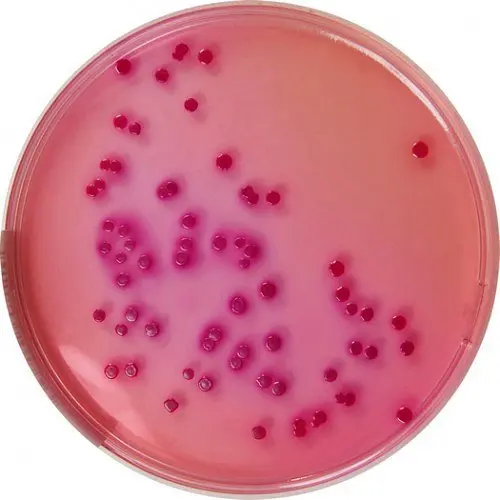VRBL agar | Principle | Preparation | Interpretation
☰ Contents :
Ⅰ. VRBL agar
VRBL Agar is a selective medium for the isolation and enumeration of coliforms in water, milk and other dairy products, dairy equipment and other foodstuffs.
The VRBL medium relies on the simultaneous use of purple crystal and bile salts to inhibit Gram-positive bacteria and neutral red as an indicator of Ph
VRBL === Violet Red Bile Agar with Lactose

VRBL Agar
Ⅱ. Preparation / Composition
Suspend the components, dehydrated powder, in water (39.5 grams in 1000 ml of purified/distilled water). The medium is boiled for a few seconds until the ingredients are completely dissolved. Do not autoclave or overheat.
Cool to 47°C and pour into Petri-dishes. The final pH should be 7.5 + 0.2.
VRBL agar composition |
|||
|---|---|---|---|
| Ingredients | gram/liter | ||
| peptone | 7.00g | ||
| Sodium Chloride | 5g | ||
| Yeast extract | 3g | ||
| Neutral Red | 0.03g | ||
| Bile salts | 1.5g | ||
| Violet Crystal | 0.002g | ||
| Lactose | 10g | ||
| Agar | 15,00g | ||
Ⅲ. Principle
If there is a culture, this means that the micro-organism is resistant to selective agents, crystal violet and bile salts, so we can assume that the strain is a gram-negative bacillus.
Microorganisms which rapidly ferment lactose produce purple colonies surrounded by a purple halo (in the case of strong acidification linked to the use of lactose). Microorganisms that do not ferment lactose or late, give pale colonies with greenish areas.
Ⅳ. Interpretation
◈ Coliforms are generally defined by their ability to rapidly ferment lactose, producing acid and gas, usually within 24 hours. Genera that are generally expected to belong to this group include Enterobacter, Klebsiella, Citrobacter, and Escherichia, especially Escherichia coli. However, species in other genera, e.g. Erwinia and Serratia, can also ferment lactose, albeit slowly, and some strains of Citrobacter and Klebsiella, as well as Salmonella arizonae and Hafnia alvei, exhibit delayed or variable.
| Organisms | Growth |
|---|---|
| E. coli | good growth, pink to purple colonies with halo. |
| Staphylococcus aureus | no growth |
| Enterococcus faecalis | no growth |
| Pseudomonas aeruginosa | Beige-pink colonies. |